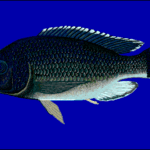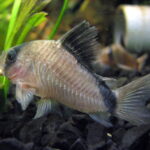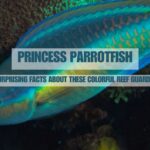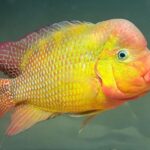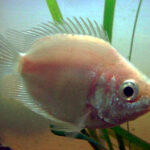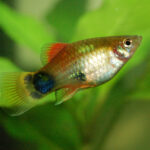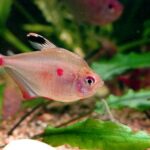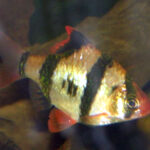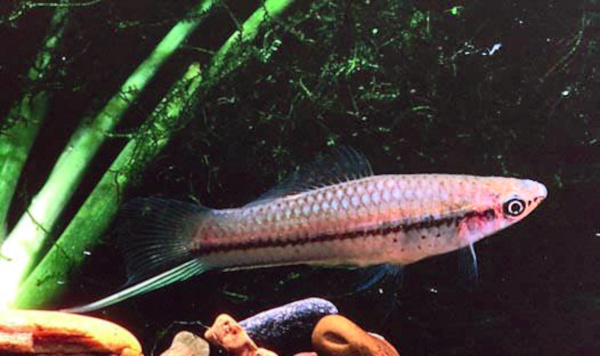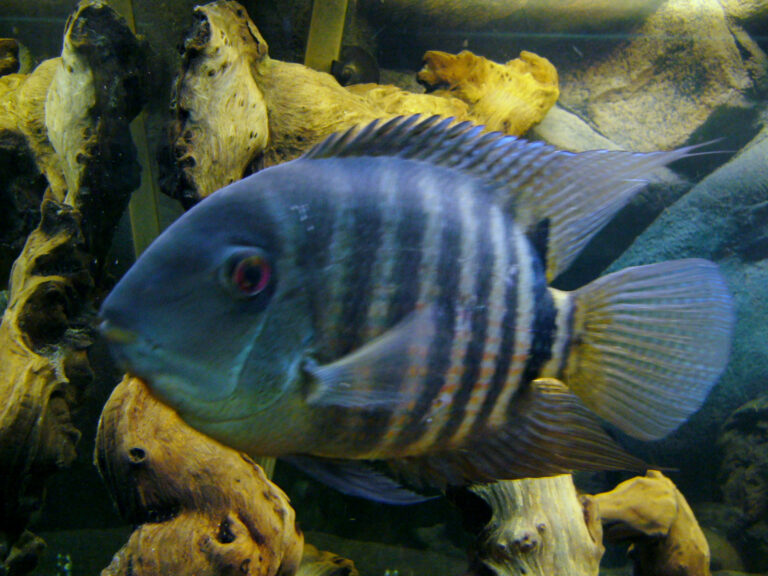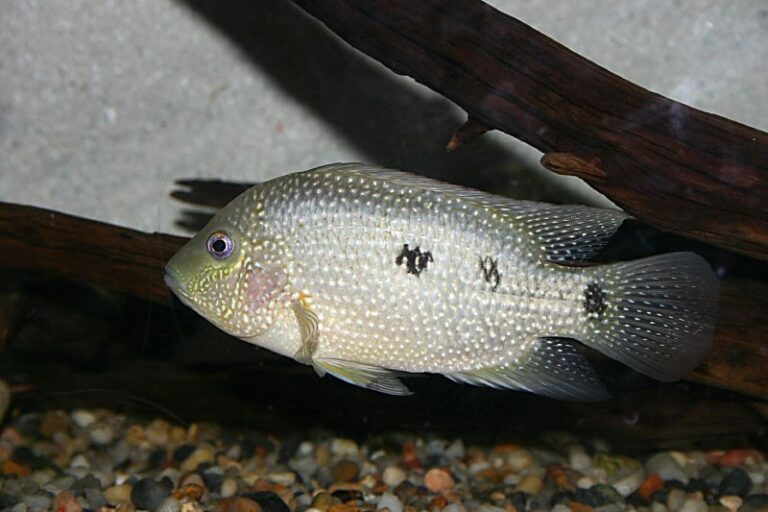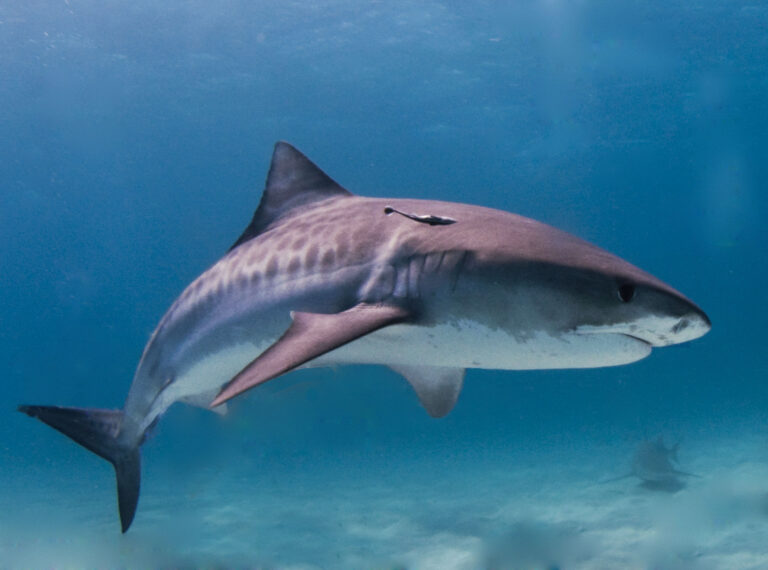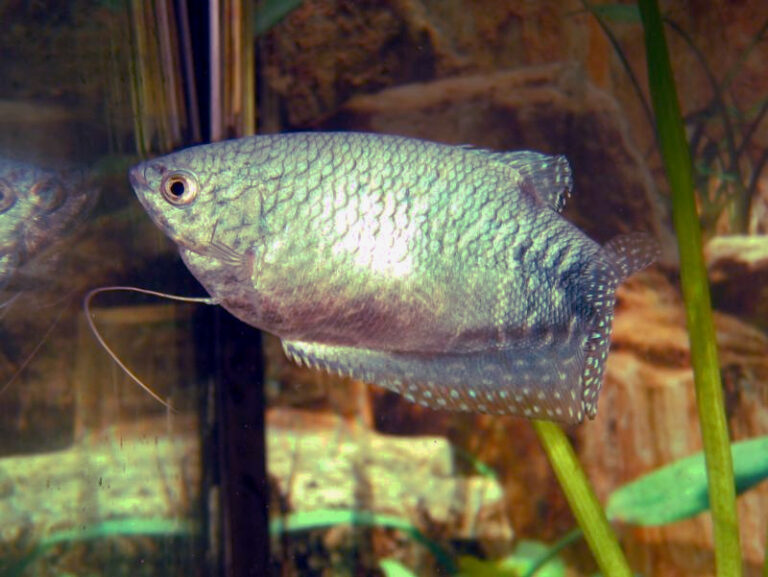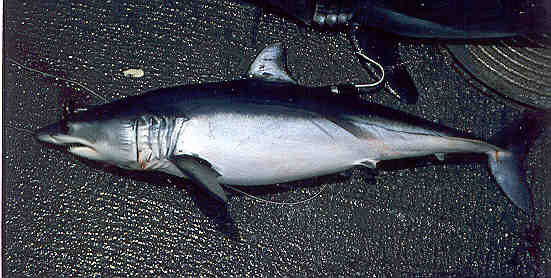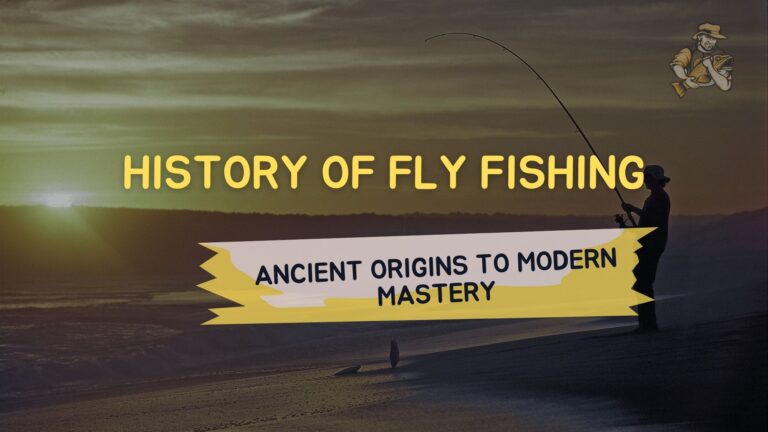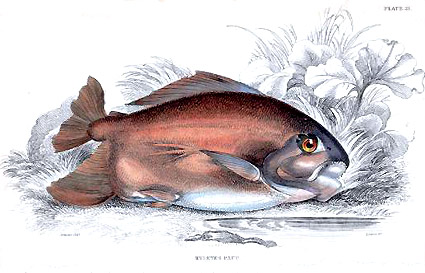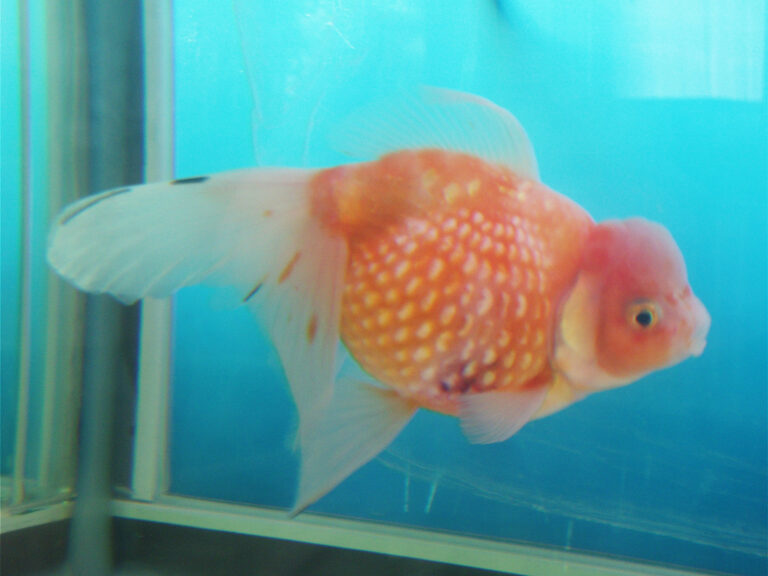Midas Cichlid
By Ryan Maron | Last Modified: June 9, 2025

The Midas Cichlid (Amphilophus citrinellus) stands as one of Central America’s most recognizable and ecologically significant freshwater fish species. This robust cichlid commands attention through its striking golden coloration and dynamic behavioral patterns, serving as both a cornerstone species in its native ecosystems and a popular subject for aquarium enthusiasts worldwide. Originally endemic to the freshwater systems of Nicaragua and Costa Rica, the Midas Cichlid has established itself as a key predator and territorial guardian within its aquatic communities.
This species plays a crucial ecological role as an intermediate predator, helping to regulate populations of smaller fish while serving as prey for larger aquatic predators. The Midas Cichlid’s territorial behavior and substrate modification activities significantly influence the physical structure of its habitat, making it an ecosystem engineer that shapes the environment for numerous other species. Its adaptability and resilience have enabled successful establishment in various aquatic systems, though this same adaptability has raised conservation concerns in non-native regions where populations have been introduced.
| Feature | Details |
|---|---|
| Common Name | Midas Cichlid |
| Scientific Name | Amphilophus citrinellus |
| Family | Cichlidae |
| Typical Size | 25-35 cm (10-14 inches), 0.5-1.5 kg |
| Habitat | Freshwater lakes and rivers |
| Diet | Omnivorous opportunist |
| Distribution | Central America, introduced globally |
| Conservation Status | Least Concern |
Taxonomy & Classification
The Midas Cichlid belongs to the family Cichlidae, one of the most diverse fish families on Earth, containing over 2,000 described species. Within this family, Amphilophus citrinellus occupies the genus Amphilophus, which encompasses approximately 23 recognized species of large Central American cichlids. The taxonomic classification places this species within the order Perciformes, representing the largest order of vertebrates and containing most of the world’s spiny-rayed fish species.
The species was first scientifically described by Günther in 1864, though its taxonomic history has undergone several revisions as our understanding of Central American cichlid diversity has expanded. Modern molecular studies have helped clarify relationships within the Amphilophus genus, confirming A. citrinellus as a distinct species while revealing complex evolutionary relationships with closely related forms. The Midas Cichlid shares its genus with notable relatives including the Red Devil Cichlid and various other Central American species that exhibit similar ecological adaptations.
Phylogenetic analyses indicate that the Amphilophus genus likely originated through adaptive radiation within the Nicaraguan Great Lakes system, with A. citrinellus representing one of the more widespread and successful lineages. This evolutionary history has produced a species remarkably well-adapted to diverse freshwater environments while maintaining the robust territorial behaviors characteristic of large neotropical cichlids.
Physical Description
The Midas Cichlid exhibits remarkable physical characteristics that distinguish it from other Central American cichlids. Adult specimens typically reach lengths of 25-35 centimeters, with exceptional individuals occasionally exceeding 38 centimeters in optimal conditions. Their deep, laterally compressed body shape provides excellent maneuverability in complex aquatic environments while maintaining the power necessary for territorial displays and predatory behaviors.
The species displays pronounced sexual dimorphism, particularly in mature individuals. Males develop more prominent nuchal humps, enlarged dorsal and anal fins, and more intense coloration during breeding periods. The characteristic golden-yellow coloration that gives the species its common name develops gradually, with juvenile fish typically exhibiting darker bars and muted tones that provide camouflage benefits in shallow vegetated areas.
Morphological features include a robust head structure with a slightly inferior mouth position, enabling efficient bottom-feeding and prey manipulation. The pharyngeal teeth are well-developed for processing both plant material and small prey items. Fin ray counts typically follow the pattern of 16-17 dorsal spines and 10-12 soft rays, with anal fins containing 5-6 spines and 8-10 soft rays. These characteristics, combined with the species’ distinctive coloration patterns, make field identification relatively straightforward for experienced observers.
The Midas Cichlid’s body plan reflects its ecological role as both a benthic forager and active predator, with proportionally large pectoral fins enabling precise maneuvering around complex substrates and vegetation.
Habitat & Distribution
The native range of the Midas Cichlid encompasses the freshwater systems of Central America, specifically the Atlantic slope drainages from southern Mexico through Costa Rica. The species achieves its highest natural densities in the Nicaraguan Great Lakes, including Lake Nicaragua and Lake Managua, where extensive shallow areas and complex shoreline habitats provide optimal conditions for feeding and reproduction.
Natural habitat preferences include shallow littoral zones with mixed substrate composition, combining sandy areas with rocky outcrops and fallen timber. Water temperatures in native habitats typically range from 24-28°C, with pH levels between 7.0-8.5 reflecting the limestone geology common throughout much of the species’ range. Dissolved oxygen levels remain relatively stable due to the shallow nature of preferred habitats and regular mixing from wind action.
The Midas Cichlid demonstrates remarkable habitat plasticity, successfully colonizing diverse freshwater environments including natural lakes, constructed reservoirs, canal systems, and even brackish estuarine areas with reduced salinity. This adaptability has facilitated establishment in non-native regions across the globe, including parts of the United States, Australia, and various tropical regions where aquaculture or aquarium releases have occurred.
Depth preferences typically range from 0.5-15 meters, with breeding activities concentrated in shallower areas where temperature regulation and parental care activities can be more effectively managed. The species shows particular affinity for areas with moderate water movement and access to both open water foraging areas and structured habitats providing territorial boundaries and spawning sites.
Diet & Feeding Behavior
The Midas Cichlid functions as an opportunistic omnivore, exhibiting feeding behaviors that reflect both its predatory capabilities and adaptability to available food resources. Primary dietary components include small fish, aquatic invertebrates, plant material, detritus, and occasionally eggs and fry of other fish species. This dietary flexibility contributes significantly to the species’ success in diverse aquatic environments.
Foraging strategies encompass both active hunting behaviors and methodical substrate examination. Adults demonstrate sophisticated prey detection abilities, utilizing both visual and chemosensory cues to locate potential food sources within complex habitats. The species exhibits particular efficiency in capturing small schooling fish through coordinated ambush tactics, often utilizing structural elements like submerged logs or rock formations as staging areas.
Feeding periodicity follows distinct daily patterns, with peak activity occurring during early morning and late afternoon periods when light conditions favor visual predation while providing adequate cover from potential threats. Seasonal variations in diet composition reflect changes in prey availability, with plant material consumption increasing during periods when animal protein sources become less abundant.
The Midas Cichlid’s pharyngeal processing capabilities enable efficient consumption of both hard and soft-bodied prey items. Feeding territories are actively defended, particularly during reproductive periods when energy demands increase substantially. This territorial feeding behavior influences the spatial distribution of other fish species within shared habitats, creating distinct ecological zones based on competitive interactions.
Behavior & Adaptations
Territorial behavior represents one of the Midas Cichlid’s most distinctive characteristics, with established adults defending areas ranging from 10-50 square meters depending on habitat quality and population density. Territory establishment involves complex assessment of physical features, food availability, and potential breeding sites, with prime locations typically including combinations of open foraging areas and structured shelter zones.
Social organization varies significantly between breeding and non-breeding periods. During non-reproductive phases, individuals may aggregate in favorable feeding areas while maintaining loose spacing patterns that minimize direct competition. Breeding season triggers dramatic behavioral changes, with pair formation involving elaborate courtship displays and joint territory establishment activities.
Communication methods include both visual displays and low-frequency vocalizations produced through specialized sonic muscles. Threat displays feature distinctive fin spreading, body darkening, and lateral positioning behaviors designed to maximize apparent size while avoiding direct physical confrontation. These behavioral adaptations prove particularly effective in species-rich cichlid communities where efficient conflict resolution mechanisms reduce injury risks.
The species demonstrates remarkable behavioral plasticity in response to environmental variations. Population density influences territory size and defense intensity, while seasonal changes in water levels trigger corresponding adjustments in habitat utilization patterns. This behavioral flexibility contributes to the Midas Cichlid’s success in both native and introduced environments, enabling rapid adaptation to novel ecological conditions.
Reproduction & Life Cycle
Reproductive biology of the Midas Cichlid follows patterns typical of substrate-spawning cichlids, with distinct seasonal timing influenced by water temperature and photoperiod cycles. Breeding season typically coincides with warmer months when water temperatures exceed 26°C consistently, providing optimal conditions for egg development and fry survival.
Pair formation involves extended courtship periods during which potential partners assess compatibility through coordinated territory defense and nest preparation activities. Spawning sites are carefully selected based on substrate characteristics, water circulation patterns, and proximity to cover areas essential for fry protection. Females deposit 200-800 eggs on cleaned rock surfaces or prepared depressions, with egg numbers correlating closely with female size and nutritional condition.
Parental care represents a defining characteristic of the species, with both parents participating in nest defense, egg ventilation, and fry guidance activities. The incubation period extends 3-4 days at temperatures of 26-28°C, followed by an additional 5-7 days during which fry absorb yolk reserves while remaining under intensive parental supervision.
Fry development progresses through distinct stages characterized by different habitat preferences and feeding requirements. Initial feeding focuses on microscopic organisms and organic particles, gradually expanding to include larger prey items as growth progresses. Parental protection continues for 4-6 weeks, during which time fry learn essential survival behaviors including predator recognition, territory navigation, and feeding techniques that will determine their future success.
Predators & Threats
Adult Midas Cichlids face predation pressure primarily from larger fish species including gar, tarpon, and other large cichlids in their native range. Juvenile stages are vulnerable to a broader range of predators including birds, reptiles, and various fish species that can exploit their smaller size and limited defensive capabilities. The species’ territorial behavior and robust build provide effective defense against many potential threats.
Habitat degradation represents the primary conservation concern affecting natural populations. Agricultural runoff introduces excessive nutrients and sediments into freshwater systems, leading to algal blooms and oxygen depletion events that stress fish populations. Urban development around lake margins eliminates critical spawning habitat while introducing pollutants that affect reproductive success.
Climate change impacts include altered precipitation patterns affecting water levels and temperature regimes in shallow lake systems. Extended drought periods can concentrate fish populations in reduced habitat areas, intensifying competition and increasing disease transmission risks. Conversely, extreme precipitation events can cause rapid water level fluctuations that disrupt breeding cycles and destroy established territories.
Introduced species competition presents ongoing challenges in both native and non-native ranges. In introduced locations, the Midas Cichlid itself becomes a potential threat to native fish communities through predation pressure and habitat competition. This dual nature as both a species requiring conservation attention in native habitats and a potential invasive threat elsewhere complicates management strategies.
Conservation Status
The International Union for Conservation of Nature (IUCN) currently classifies the Midas Cichlid as Least Concern, reflecting the species’ wide distribution, stable population trends, and adaptability to diverse environmental conditions. However, this classification masks significant regional variations in population status and conservation needs across the species’ native range.
Population monitoring in the Nicaraguan Great Lakes indicates stable but declining trends in some areas, particularly near urban centers where habitat degradation and water quality issues affect fish communities. Conservation efforts focus on watershed protection, pollution control, and sustainable fisheries management practices that maintain ecosystem integrity while supporting local economic needs.
International trade regulations under CITES do not currently apply to the Midas Cichlid, though some countries have implemented restrictions on importation to prevent establishment of invasive populations. The species’ popularity in the aquarium trade necessitates continued monitoring of release incidents and development of rapid response protocols for newly detected populations.
Regional conservation strategies emphasize habitat restoration, particularly in degraded shoreline areas where spawning success has declined. Collaborative efforts between government agencies, academic institutions, and local communities have produced promising results in several lake systems, demonstrating the effectiveness of integrated conservation approaches. According to FishBase research databases, continued monitoring of population trends remains essential for detecting changes in conservation status.
Human Interaction
The Midas Cichlid has established significant relationships with human communities throughout its range, serving roles in subsistence fisheries, aquaculture operations, and recreational fishing activities. In Central America, the species supports important artisanal fisheries that provide protein and income for coastal and lakeside communities, with traditional fishing methods including nets, lines, and fish traps designed specifically for cichlid capture.
Aquaculture applications have expanded significantly in recent decades, with the Midas Cichlid proving well-suited to pond-based production systems. Growth rates, disease resistance, and market acceptance combine to make this species economically viable for small-scale fish farming operations. Production techniques emphasize natural feeding behaviors and territorial requirements to optimize fish health and growth performance.
The international aquarium trade represents another significant form of human interaction, though this relationship raises concerns about potential introductions to non-native environments. Responsible aquarium keeping requires understanding of the species’ space requirements, territorial behavior, and potential for escape or release into local water systems.
Educational and research applications leverage the Midas Cichlid’s complex behaviors and ecological relationships to advance understanding of fish biology, behavior, and evolution. University programs and research institutions utilize this species for studies ranging from basic behavior research to applied aquaculture development, contributing valuable knowledge while maintaining ethical research standards.
Interesting Facts
The Midas Cichlid exhibits remarkable color-changing abilities that extend beyond simple breeding coloration. Individuals can rapidly adjust their pigmentation in response to social interactions, territorial disputes, and environmental changes, with some fish capable of shifting from dark barred patterns to brilliant golden hues within minutes of environmental changes.
Parental behavior includes sophisticated fry herding techniques where adults use coordinated swimming patterns and specific body positions to guide large groups of offspring through complex habitats. Parents communicate with fry through subtle fin movements and positioning cues that direct group movements while maintaining protective formations around vulnerable young fish.
The species demonstrates unexpected problem-solving abilities in both natural and laboratory settings. Captive individuals learn to manipulate simple mechanisms, remember feeding schedules, and recognize individual humans through visual cues. This cognitive flexibility likely contributes to their success in diverse environments and complex social situations.
Archaeological evidence suggests that indigenous Central American cultures incorporated the Midas Cichlid into both subsistence practices and ceremonial activities. Ancient fish remains found at archaeological sites indicate sophisticated understanding of seasonal fishing patterns and habitat preferences that enabled sustainable harvest of these important food fish. The relationship between cichlid species and human communities continues to evolve as conservation needs and economic opportunities develop.
Unique among Central American cichlids, some Midas Cichlid populations have developed specialized feeding behaviors targeting specific prey types unavailable to other fish species, demonstrating ongoing evolutionary adaptation even within established ecosystems.
Frequently Asked Questions
How large do Midas Cichlids grow in aquarium settings?
Midas Cichlids typically reach 20-30 centimeters in aquarium environments, slightly smaller than wild specimens due to space constraints and feeding differences. Males generally grow larger than females and develop more pronounced coloration and fin extensions. Optimal growth requires adequate tank space, high-quality nutrition, and appropriate water conditions that mimic their natural habitat parameters.
Are Midas Cichlids suitable for community aquarium settings?
Midas Cichlids are generally not recommended for community tanks due to their aggressive territorial behavior and large size requirements. They perform best in species-specific setups or with carefully selected tankmates that can handle their assertive nature. Successful community integration requires extensive space, multiple territories, and compatible species selection based on size and temperament matching.
What distinguishes Midas Cichlids from closely related Central American species?
Midas Cichlids can be distinguished from related species through their characteristic golden coloration, specific fin ray counts, and distinctive body proportions. Unlike Red Devil Cichlids, Midas Cichlids typically exhibit more stable coloration patterns and different head profiles. Positive identification often requires examination of multiple characteristics including coloration, morphology, and behavioral patterns.
How do Midas Cichlids impact ecosystems where they have been introduced?
Introduced Midas Cichlid populations can significantly alter local fish communities through predation pressure on native species and competition for territorial resources. Their substrate modification behaviors change habitat structure, potentially affecting spawning success of native fish. Management of introduced populations requires ongoing monitoring and may include population control measures to protect native biodiversity.
Conclusion
The Midas Cichlid represents a fascinating example of evolutionary success and ecological adaptability within freshwater fish communities. Its role as both a keystone species in native Central American ecosystems and a model organism for understanding cichlid biology underscores the importance of comprehensive conservation strategies that balance ecological preservation with sustainable human use. Continued research and monitoring efforts remain essential for maintaining healthy populations while managing the challenges posed by introduced populations in non-native environments.
Share The Article:
More Fish Species:
-
Green Swordtail
The Green Swordtail (Xiphophorus hellerii) represents one of the most recognizable and ecologically significant freshwater fish species in both…
-
Severum Cichlid
The Severum Cichlid represents one of South America’s most recognizable and ecologically significant freshwater fish species. Known scientifically as…
-
Texas Cichlid
The Texas Cichlid (Herichthys cyanoguttatus) stands as one of North America’s most distinctive freshwater fish species, representing the sole…
-
Yellow Lab Cichlid
The Yellow Lab Cichlid (*Labidochromis caeruleus*) stands as one of Africa’s most recognizable freshwater fish species, distinguished by its…
-
Tiger Shark
The Tiger Shark (Galeocerdo cuvier) represents one of the ocean’s most formidable apex predators, earning its distinctive name from…
-
Gold Gourami
The Gold Gourami (Trichopodus trichopterus) represents one of Southeast Asia’s most recognizable freshwater fish species, distinguished by its robust…
Discover
-
7 Unusual Ways to Catch Trout in Lakes (That Most Anglers Miss)
Chasing trout in lakes can be maddeningly difficult. Trust me, I’ve spent countless mornings staring at a dead rod…
-
Texas Fishing License Guide: 2025 Costs & Requirements
I still remember the day a Texas game warden approached me on Lake Texoma while I was reeling in…
-
Michigan Fishing License 2025: Complete Cost & Requirements Guide
Ask any angler about the most frustrating part of fishing, and paperwork will likely rank right up there with…
-
Shortfin Mako Shark
The Shortfin Mako Shark stands as one of the ocean’s most remarkable predators, combining exceptional speed with sophisticated hunting…
-
Unlock Killer Saltwater Jigging Techniques: What I’ve Learned After Thousands of Drops
The first time I tried saltwater jigging, I was on my buddy Dave’s boat in the Gulf of Mexico…
-
History of Fly Fishing: Ancient Origins to Modern Mastery
The gentle art of fly fishing has captivated anglers for centuries, evolving from a practical method of obtaining food…
Discover
-
Pacu Fish
Pacu fish represent one of South America’s most ecologically significant freshwater species, encompassing several closely related members of the…
-
Winter Fishing Tips: 7 Cold-Weather Tactics Successful Anglers Use
Most anglers pack away their gear when the temperature drops, but the dedicated few know something the others don’t:…
-
Pearlscale Goldfish
The Pearlscale Goldfish represents one of the most distinctive and captivating varieties of ornamental carp, distinguished by its characteristic…
-
How to Use a Spinnerbait: Complete Guide for Beginners
In my three decades of fishing experience, I’ve found few lures as versatile and effective as the humble spinnerbait….
-
Congo Tetra
The Congo Tetra stands as one of Africa’s most remarkable freshwater fish species, captivating aquarists and ichthyologists alike with…
-
Planning a Family Fishing Trip: Tips for a Hooked-on-Fun Adventure
There’s something almost magical about watching a kid’s face light up when they feel that first tug on their…

